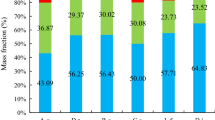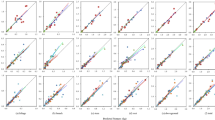Abstract
Shrubs are important components of alpine mountain ecosystems in terms of productivity and diversity. An estimation of shrub biomass using allometric equations represents a non-destructive option for obtaining useful quantitative data. However, species-specific allometric equations for alpine shrubs have yet to be developed in sufficient detail. This study proposed allometric equations that can be used to estimate aboveground biomass of alpine shrubs. These are based on easily acquired descriptive parameters of plant height (H), crown area (C), basal diameter (D), and D 2 H (basal diameter squared × total H) for four of the most abundant alpine shrub species in the upstream ecosystems of China’s Heihe River Basin: Salix cupularis, Salix oritrepha, Potentilla fruticosa, and Caragana jubata. The results show that several equations relating biomass categories to H, C, and D 2 H provided significant (P < 0.01) data for measuring aboveground biomass; the determination coefficients (R 2) varied from 0.95 to 0.97 and fit indices (FIs) varied from 0.96 to 0.97. The form and variables comprising the allometric equations differed among species-specific models. Aboveground shrub biomass increased with D 2 H for S. cupularis and C. jubata, whereas it increased with C and H for P. fruticosa. For S. oritrepha, an exponential function provided the best-fit model with C. However, the results could provide useful approximations of aboveground biomass of similar shrubs currently lacking such equations. The allometric equations also provide a useful and non-destructive method of estimating aboveground shrub biomass in alpine ecosystems.



Similar content being viewed by others
References
Bartelink HH (1997) Allometric relationships for biomass and leaf area of beech (Fagus sylvatica L.). Ann For Sci 54(1):39–50
Basuki TM, Van Laake PE, Skidmore AK, Hussinl YA (2009) Allometric equations for estimating the above-ground biomass in tropical lowland Dipterocarp forests. Forest Ecol Manag 257:1684–1694
Bombelli A, Henry M, Castaldi S, AduBredu S, Arneth A, de Grandcourt A, Grieco E, Kutsch WL, Lehsten V, Rasile A, Reichstein M, Tansey K, Weber U, Valentini R (2009) An outlook on the Sub-Saharan Africa carbon balance. Biogeosciences 6:2193–2205
Brand GJ, Smith WB (1985) Evaluating allometric shrub biomass equationsfit to generated data. Can J Bot 63:63–67
Cai Z, Liu QJ, Ouyang QL (2006) Estimation model for biomass of shrub in Qianyanzhou experiment station. J Cent South Forest Univ 26:15–23 (in Chinese with English Abstract)
Case BS, Hall RJ (2008) Assessing prediction errors of generalized tree biomass and volume equations for the boreal forest region of west-central Canada. Can J Forest Res 38:878–889
Chapin FS, Bret-Harte MS, Hobbie SE, Zhong HL (1996) Plant functional types as predictors of transient responses of arctic vegetation to global change. J Veg Sci 7(3):347–358
Chen RS, Kang ES, Ji XB, Yang JP, Wang JH (2007) An hourly solar radiation model under actual weather and terrain conditions: a case study in Heihe river basin. Energy 32:1148–1157
Crow TR, Schlaegel BE (1988) A guide to using regression equations for estimating tree biomass. North J Appl For 5:15–22
David V, Sautour B, Galois R, Chardy P (2006) The paradox high zooplankton biomass low vegetal particulate organic matter in high turbidity zones: what way for energy transfer? J Exp Mar Biol Ecol 333:202–218
Davison AC, Hinkley DV (1997) Bootstrap methods and their application. Cambridge University Press, Cambridge
Díaz S, Cabido M (1997) Plant functional types and ecosystem function in relation to global change. J Veg Sci 8(4):463–474
Dong J, Tao F, Zhang G (2011) Trends and variation in vegetation greenness related to geographic controls in middle and eastern Inner Mongolia, China. Environ Earth Sci 62(2):245–256
Draper NR, Smith H (1998) Applied regression analysis, 2nd edn. Wiley, New York
Duckworth JC, Kent M, Ramsay PM (2000) Plant functional types: an alternative to taxonomic plant community description in biogeography? Prog Phys Geog 24(4):515–542
Elzein TM, Blarquez O, Gauthier O, Carcaillet C (2011) Allometric equations for biomass assessment of subalpine dwarf shrubs. Alpine Bot 121:129–134
Fang JY, Guo ZD, Piao SL, Chen AP (2007) Terrestrial vegetation carbon sinks in China, 1981–2000. Sci China Earth Sci 50:1341–1350
Foroughbakhch R, Reyes G, Alvarado-Vázquez MA, Hernández-Piñero J, Alejandra Rocha-Estrada A (2005) Use of quantitative methods to determine leaf biomass on 15 woody shrub species in northeastern Mexico. Forest Ecol Manag 216:359–366
Ganguly S, Zhang G, Nemani R, Miles C, Wang W, Saatchi S, Yu Y, Myneni R (2012) A simple parametric estimation of live forest aboveground biomass in california using satellite derived metrics of canopy height and leaf area index. AGU Fall Meet Abstr 1:0433
Haase R, Haase P (1995) Above-ground biomass estimates for invasive trees and shrubs in the Pantanal of Mato Grosso, Brazil. Forest Ecol Manag 73:29–35
Halpern CB, Miller EA, Geyer MA (1996) Equations for predicting aboveground biomass of plant species in early successional forests of the western Cascade Range, Oregon. Northwest Sci 70:306–320
Harrington G (1979) Estimation of above-ground biomass of trees and shrubs in a Eucalyptus populaca F. Muell woodland by regression of mass on trunk diameter and plant height. Aust J Bot 27:135–143
He LY, Kang XG, Fan XL, Gao Y, Feng QX (2011) Estimation and analysis of understory shrub biomass in Changbai Mountains. J Nanjing Forest Univ (Nat Sci Edition) 35:45–50 (in Chinese with English Abstract)
Hierro JL, Branch LC, Villareal D, Clark KL (2000) Predictive equations for biomass and fuel characteristics of Argentine shrubs. J Range Manag 53:617–621
Hou XY (2001) Vegetation Atlas of China (1: 1 000 000). Science Press, Beijing (in Chinese)
Houghton RA (2007) Balancing the global carbon budget. Annu Rev Earth Planet Sci 35:313–347
Hu HF, Wang ZW, Liu GH, Fu BJ (2006) Vegetation carbon storage of major shrubland in china. J Plant Ecol 60:539–544 (in Chinese with English Abstract)
Keller M, Palace M, Hurtt G (2001) Biomass estimation in the Tapajos National Forest, Brazil: examination of sampling and allometric uncertainties. Forest Ecol Manag 154:371–382
Lavorel S, Díaz S, Cornelissen JHC, Garnier E, Harrison SP, McIntyre S, Urcelay C (2007) Plant functional types: are we getting any closer to the Holy Grail? In: Canadell J, Pitelka LF, Pataki D (eds) Terrestrial ecosystems in a changing World. Springer, New York, pp 149–164
Li YN, Zhao L, Wang QX, Du MY, Gu S, Xu SX, Zhang FW, Zhao XQ (2006) Estimation of biomass and annual turnover quantities of Potentilla froticosa shrub. Acta Agrestia Sinica 14:72–76 (in Chinese with English Abstract)
Lin W, Li JS, Zheng BF, Guo JM, Hu LL (2010) Models for estimating biomass of twelve shrub species in Jinggang Mountain nature reserve. J Wuhan Bot Res 28:725–729 (in Chinese with English Abstract)
Liu C, Westman CJ (2009) Biomass in a Norway spruce-Scots pine forest: a comparison of estimation methods. Boreal Environ Res 14:875–888
Liu XL, Liu SR, Su YM, Cai XH, Ma QY (2006) Aboveground biomass of Quercus aquifolioides shrub community and its responses to altitudinal gradients in Balangshan Mountain, Shichuan Province. Cientia Silvae Sinicae 42:1–7 (in Chinese with English Abstract)
Liu J, Liu XL, Hou LM (2011) Changes and ecological vulnerability of landscape pattern in Eastern Qilian Mountains. Arid Land Geogr 35:795–805 (in Chinese with English Abstract)
Liu Z, Chen R, Song Y, Han C (2014) Distribution and estimation of aboveground biomass of alpine shrubs along an altitudinal gradient in a small watershed of the Qilian Mountains, China. J Mt Sci Engl. doi:10.1007/s11629-013-2854-7
Lodhiyal LS, Lodhiyal N (1997) Variation in biomass and net primary productivity in short rotation high density central Himalayan poplar plantations. Forest Ecol Manag 98:167–179
Luo T, Li W, Zhu H (2002) Estimated biomass and productivity of natural vegetation on the Tibetan Plateau. Ecol Appl 12:980–997
Manzoni S, Vico G, Katul G, Philip A, Wayne P, Sari P, Amilcare P (2011) Optimizing stomatal conductance for maximum carbon gain under water stress: a meta-analysis across plant functional types and climates. Funct Ecol 25(3):456–467
Morgan WB, Moss PA (1985) Biomass energy and urbanisation: commercial factors in the production and use of biomass fuels in tropical Africa. Biomass 6:285–299
Murray RB, Jacobson MQ (1982) An evaluation of dimension analysis for predicting shrub biomass. J Range Manag 35:451–454
Myers-Smith IH (2011) Shrub encroachment in arctic and alpine tundra: mechanisms of expansion and ecosystem impacts. Ph.D. thesis, University of Alberta
Návar J, Méndez E, Nájera A, Graciano J, Dale V, Parresol B (2004) Biomass equations for shrub species of Tamaulipan thornscrub of North-eastern Mexico. J Arid Environ 59:657–674
Oyonarte PB, Cerrilo RMN (2003) Aboveground phytomass for major species in shrub ecosystem of western Andalusia. Investigación Agraria: Sistemas y Recursos Forestales 12:47–55
Paton D, Nuñez J, Bao D, Muñoz A (2002) Forage biomass of 22 shrub species from Monfragüe Natural Park (SW Spain) assessed by log-log regression models. J Arid Environ 52:223–231
Peek JM (1970) Relation of canopy area and volume to production of three woody species. Ecology 51:1098–1101
Piao SL, Fang JY, Ciais P (2009) The carbon balance of terrestrial ecosystems in China. Nature 458:1009–1013
Rapp M, Santa Regina I, Rico M, Gallego HA (1999) Biomass, nutrient content, litterfall and nutrient return to the soil in Mediterranean oak forests. Forest Ecol Manag 119:39–49
Sah JP, Ross MS, Koptur S, Snyder JR (2004) Estimating aboveground biomass of broadleaved woody plants in the understory of Florida Keys pine forests. Forest Ecol Manag 203:319–329
Schlaegel B (1981) Testing, reporting, and using biomass estimation models. In: Proceedings of 1981 Southern Forest Biomass Workshop. The Belle W. Baruch Forest Science Institute, Clemson University, SC, USA, pp. 95–112
Seidel D, Fleck S, Leuschner C, Hammett T (2011) Review of ground-based methods to measure the distribution of biomass in forest canopies. Ann For Sci 68(2):225–244
Singh V, Tewari A, Kushwaha SPS, Dadhwalb VK (2011) Formulating allometric equations for estimating biomass and carbon stock in small diameter trees. Forest Ecol Manag 261:1945–1949
Sironen S, Kangas A, Maltamo M, Kangas J (2003) Estimating individual tree growth with nonparametric methods. Can J Forest Res 33:444–449
Spadavecchia L, Williams M, Bell R, Stoy P, Huntley B, van Wijk MT (2008) Topographic controls on the leaf area index and plant functional type of a tundra ecosystem. J Ecol 96(6):1238–1251
Tape KEN, Sturm M, Racine C (2006) The evidence for shrub expansion in northern Alaska and the Pan-Arctic. Global Change Biol 12:686–702
Uso JL, Mateu J, Karjalainen T, Salvador P (1997) Allometric regression equations to determine aerial biomasses of Mediterranean shrubs. Plant Ecol 132:59–69
Ustin SL, Gamon JA (2010) Remote sensing of plant functional types. New Phytol 186(4):795–816
Wang GH, Zhou GS, Yang LM, Li Z (2002) Distribution, species diversity and life-form spectra of plant communities along an altitudinal gradient in the northern slopes of Qilianshan Mountains, Gansu, China. Plant Ecol 165:169–181
Wang P, Xie D, Zhou Y, Youhao E, Zhu Q (2014) Estimation of net primary productivity using a process-based model in Gansu Province, Northwest China. Environ Earth Sci 71(2):647–658
Xiang WH, Liu SH, Deng XW, Shen AH, Lei XD, Tian DL, Zhao MF, Peng CH (2011) General allometric equations and biomass allocation of Pinus massoniana trees on a regional scale in southern China. Ecol Res 26:697–711
Yashiro Y, Shizu Y, Hirota M, Shimono A, Ohtsuka T (2011) The role of shrub (Potentilla fruticosa) on ecosystem CO2 fluxes in an alpine shrub meadow. J Plant Ecol 3:89–97
Zeng HQ, Liu QJ, Feng ZW (2010) Biomass equations for four shrub species in subtropical China. J Veg Res 15:83–90
Zhang ZM, Han TH (2008) A mathematical model for aboveground biomass in the Gannan, Gansu province. Pratacultural Sci 25:10–13 (in Chinese with English Abstract)
Acknowledgments
Thanks to Dr. LaMoreaux and anonymous reviewers for their valuable comments. The National Natural Science Foundation of China (Grant Nos. 91025011 and 91125013) and the National Science Fund for Excellent Youth Scholars of China (Grant No.41222001) supported this research.
Author information
Authors and Affiliations
Corresponding author
Rights and permissions
About this article
Cite this article
Liu, Z., Chen, R., Song, Y. et al. Estimation of aboveground biomass for alpine shrubs in the upper reaches of the Heihe River Basin, Northwestern China. Environ Earth Sci 73, 5513–5521 (2015). https://doi.org/10.1007/s12665-014-3805-5
Received:
Accepted:
Published:
Issue Date:
DOI: https://doi.org/10.1007/s12665-014-3805-5




